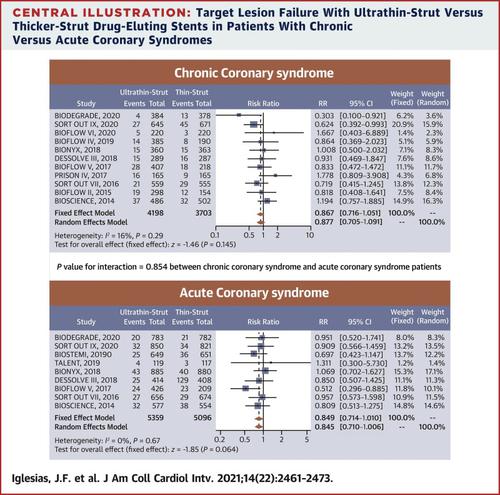JACC: Cardiovascular Interventions ( IF 11.3 ) Pub Date : 2021-11-15 , DOI: 10.1016/j.jcin.2021.09.028 Juan F Iglesias 1 , Sophie Degrauwe 1 , Murat Cimci 1 , Quentin Chatelain 1 , Marco Roffi 1 , Stephan Windecker 2 , Thomas Pilgrim 2

|
Objectives
The authors sought to compare the differential effects of ultrathin-strut and thicker-strut drug-eluting stents (DES) in patients with chronic (CCS) versus acute (ACS) coronary syndromes.
Background
Newest-generation ultrathin-strut DES reduce target lesion failure (TLF) compared with thicker-strut second-generation DES in patients undergoing percutaneous coronary intervention.
Methods
PubMed, Embase, and Cochrane Central Register of Controlled Trials were searched for randomized controlled trials comparing newer-generation ultrathin-strut (<70 μm) versus thicker-strut (≥70 μm) DES. Patients were divided based on baseline clinical presentation (CCS versus ACS). The primary endpoint was TLF, a composite of cardiac death, target vessel myocardial infarction, or clinically indicated target lesion revascularization (TLR).
Results
A total of 22,766 patients from 16 randomized controlled trials were included, of which 9 trials reported TLF rates in ACS patients. At a mean follow-up of 12.2 months, the risk of TLF was lower among patients treated with ultrathin-strut compared with thicker-strut DES (risk ratio [RR]: 0.85; 95% CI: 0.75-0.95; P = 0.006). The difference was driven by a lower risk of clinically-indicated TLR (RR: 0.75; 95% CI: 0.63-0.89; P < 0.001) among patients treated with ultrathin-strut DES. The treatment effect was consistent between patients presenting with CCS and ACS (relative RR: 0.97; 95% CI: 0.73-1.31; P for interaction = 0.854). In patients with ST-segment elevation myocardial infarction, TLF risk was lower among those treated with ultrathin- compared with thicker-strut DES (RR: 0.74; 95% CI: 0.54-0.99; P = 0.049).
Conclusions
Ultrathin-strut DES reduce the risk of TLF compared with thicker-strut second-generation DES in patients undergoing percutaneous coronary intervention, a difference caused by a lower risk of ischemia-driven TLR. The treatment effect was consistent among patients with CCS and ACS.
中文翻译:

新一代超薄支架与厚支架药物洗脱支架在慢性和急性冠状动脉综合征中的不同作用
目标
作者试图比较超细支架和粗支架药物洗脱支架 (DES) 在慢性 (CCS) 与急性 (ACS) 冠状动脉综合征患者中的不同效果。
背景
在接受经皮冠状动脉介入治疗的患者中,与较厚的第二代 DES 相比,最新一代的超薄型 DES 可减少靶病变失败 (TLF)。
方法
PubMed、Embase 和 Cochrane Central Register of Controlled Trials 搜索了比较新一代超薄支柱(<70 μm)与较厚支柱(≥70 μm)DES 的随机对照试验。根据基线临床表现(CCS 与 ACS)对患者进行分类。主要终点是 TLF,即心源性死亡、靶血管心肌梗死或临床指征的靶病变血运重建 (TLR) 的复合终点。
结果
共纳入来自 16 项随机对照试验的 22,766 名患者,其中 9 项试验报告了 ACS 患者的 TLF 率。在平均 12.2 个月的随访中,超薄支架治疗的患者 TLF 风险低于厚支架 DES(风险比 [RR]:0.85;95% CI:0.75-0.95;P = 0.006) . 这种差异是由于在接受超薄支撑 DES 治疗的患者中临床指示的 TLR 风险较低(RR:0.75;95% CI:0.63-0.89;P < 0.001)。CCS 和 ACS 患者的治疗效果一致(相对 RR:0.97;95% CI:0.73-1.31;P交互作用 = 0.854)。在 ST 段抬高型心肌梗死患者中,接受超薄型 DES 治疗的患者 TLF 风险较低(RR:0.74;95% CI:0.54-0.99;P = 0.049)。
结论
在接受经皮冠状动脉介入治疗的患者中,与较厚的第二代 DES 相比,超薄型 DES 可降低 TLF 的风险,这一差异是由于缺血驱动的 TLR 风险较低所致。CCS 和 ACS 患者的治疗效果一致。


























 京公网安备 11010802027423号
京公网安备 11010802027423号